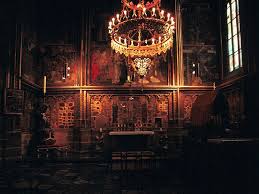Good King Wenceslas is a popular Christmas carol that tells a story of Good King Wenceslas braving harsh winter weather to give alms to a poor peasant on the Feast of Stephen (the second day of Christmas, December 26). During the journey, his page is about to give up the struggle against the cold weather, but is enabled to continue by following the king’s footprints, step for step, through the deep snow. The legend is based on the life of the historical Saint Wenceslaus I, Duke of Bohemia or Svatý Václav in Czech (907–935).
(I remember the first time I was in Prague and stood on the castle battlements looking out across the city during a light snowfall. The city seemed dusted with powder sugar and looked like a fairyland. It was magical. And then–I realized that I could more or less see the cloister of St. Agnes across the river, the famous “St. Agnes’ fountain” of the popular Christmas carol. I was standing more or less where the good king himself must have been standing when he asked his page about the identity of the poor man they saw struggling with his load of winter fuel! The cloister of St. Agnes now houses the National Museum’s breathtaking collection of medieval art. A day or so later, it was breathtaking to walk through the hallways and rooms of the thirteenth century cloister to view some of the most stunning medieval art I have ever seen — even better than the world-famous collection of the Metropolitan Museum of Art at the Cloisters! When you visit Prague, I cannot urge you too strongly to take the time to visit St. Agnes’ cloister along the bend of the river.)
Don’t recall the details of the story? Listen to it now.
In 1853, English hymnwriter John Mason Neale wrote the “Wenceslas” lyrics, in collaboration with his music editor Thomas Helmore, and the carol first appeared in Carols for Christmas-Tide, 1853. Neale’s lyrics were set to a tune based on a 13th-century spring carol “Tempus adest floridum” (“The time is near for flowering”) first published in the 1582 Finnish song collection Piae Cantiones.
Wenceslas was considered a martyr and a saint immediately after his death in the 10th century, when a cult of Wenceslas grew up in Bohemia and in England. Within a few decades of Wenceslas’s death, four biographies of him were in circulation. These hagiographies had a powerful influence on the High Middle Ages conceptualization of the rex justus, or “righteous king”—that is, a monarch whose power stems mainly from his great piety, as well as from his princely vigor.
Although Wenceslas was, during his lifetime, only a duke, Holy Roman Emperor Otto I posthumously “conferred on [Wenceslas] the regal dignity and title” and that is why, in the legend and song, he is referred to as a “king”. The usual English spelling of Duke Wenceslas’s name, Wenceslaus, is occasionally encountered in later textual variants of the carol, although it was not used by Neale in his version. (Wenceslas is not to be confused with King Wenceslaus I of Bohemia [Wenceslaus I Premyslid], who lived more than three centuries later).
[This post was very popular when I first published it in December 2013. This is a slightly revised version.]


In the lyrics I remember, “Sire, he lives a good league hence, underneath the mountain, right against the forest fence, by St. Agnes fountain” What does “Underneath the mountain” mean? did “yonder peasant” live in a cave? I think “Forest Fence” means at the edge of the forest.
Thanks.
Cecil
Cecil: Thank you for writing! Yes, the “forest fence” is the edge of the forest. “Underneath the mountain” means the base of the mountain. The cloister and fountain of St. Agnes in Prague sits on the banks of the Vltava river; a massive bluff rises immediately across the river and overlooks the city. The “yonder peasant” lived at the edge of the forest, near the St. Agnes cloister at the base of the mountain/bluff across the river.
Happy upcoming St. Stephen’s Day!
SM
out of curiosity, is that really that much of a distance? I’m aware that the city will have been different at that time so it might have been but I’m just curious. Also, what are your thoughts on whether the ‘king’ and his page ever actually reached the ‘peasant’ as the song never specifically tells us 😀
Sarah: Thanks for writing! The distance is about 2-3 miles… just enough to be difficult in heavy snow! I think the king and page reached the poor man’s house and were able to deliver food and firewood to the poor man who had arrived home already.
A league can vary depending on the country, anywhere from about 2.5 miles to 4.5 miles. England puts it at 3 statute miles.
Think on the circumstances, an old man, in the snow, gathering what wood he could break by hand – assuming that, like many places, peasants were forbidden to cut wood, but could gather any deadfall and what could be broken off by hand. Three miles (actually, 6 miles – 3 out and 3 back) is a long way to be walking and gathering wood in winter.